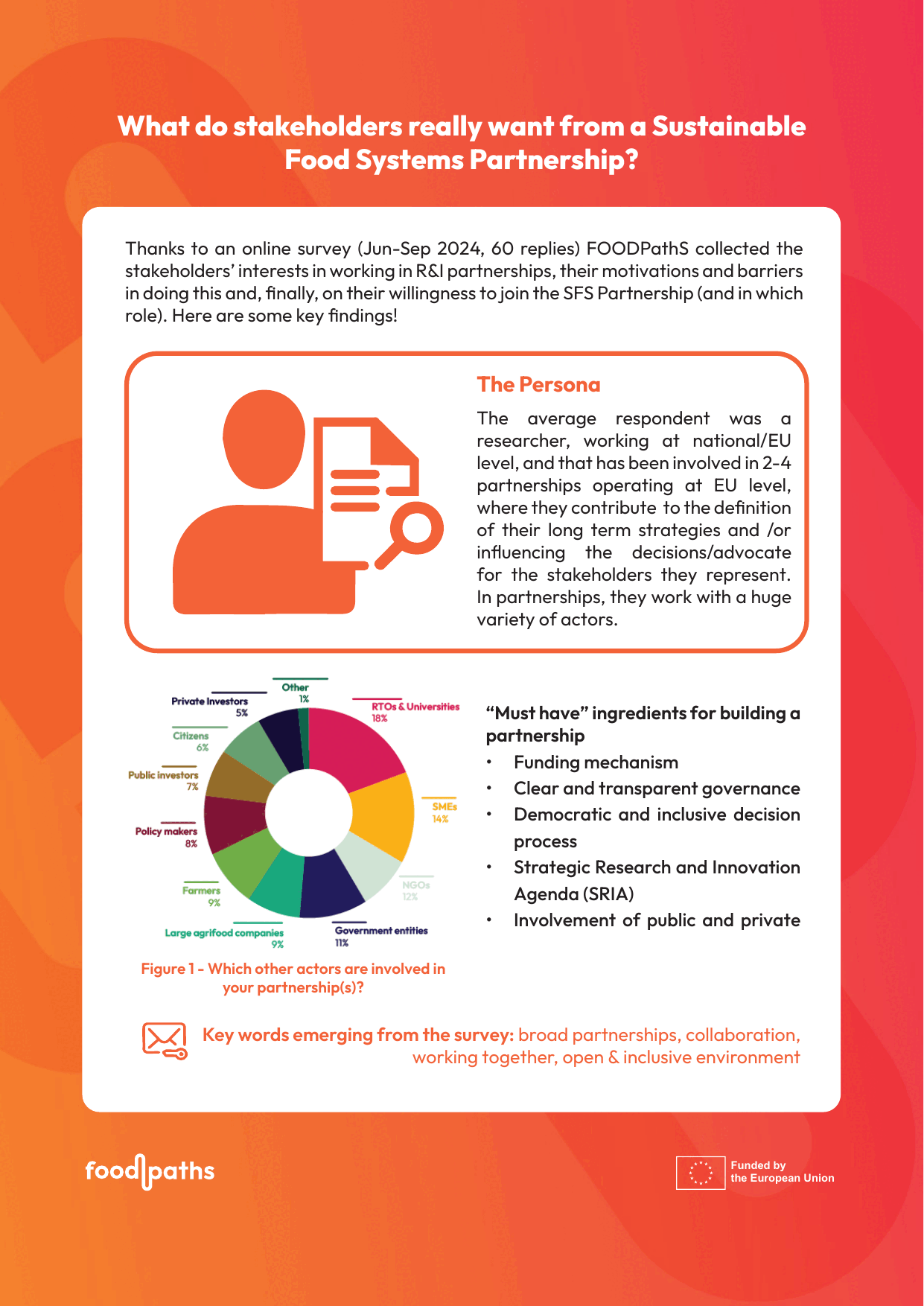Tool 8: Feedback Collection
Your next inclusive partnership starts with listening—collect the feedback that matters.

This tool draws from the FOODPathS “Feedback from Society” report, which analyses responses from a multi-stakeholder survey. It captures how different food system actors see their role in partnerships, what kind of activities they are ready to engage in, and how they prefer to be reached. The tool includes a template survey that can be adapted by others to gather similar insights, a deliverable report and a factsheet based on the key outcomes.
On the other hand, the results of the FOODPathS survey constitute a precious tool for European Partnerships (i.e., FutureFoodS, PRIMA, EIT Food, etc.), as well as for other similar initiatives, operating at local, regional, national and international levels. In particular, the main element of interest is represented by recommendations and action points.
Who is this tool for?
- Partnerships,
- policymakers and
- representatives of food systems actors who want to build inclusive, impactful, and truly collaborative partnerships for sustainable food systems.
What are the benefits?



Lessons Learned
Partnership definition and meaning: The survey defined a context where, besides the R&I Partnerships of the EC (FutureFoodS, Agroecology Partnership, etc.), stakeholders are working together to transform the European food systems through living labs, policy councils, EU-funded R&I projects and many more initiatives. They cannot be excluded from the “partnership” definition because not falling in the description provided by the EC: on the contrary, they should be considered as “a different level of partnership”, that should dialogue and interact with the institutionalised initiatives of the EC. In this context, FOODPathS can play the role of connecting this different level of partnerships with the formal ones built by the EC.
Collaboration is the most relevant benefit of working in a partnership: an ideal partnership requires a good collaborative environment, that, together with the provision of a funding mechanism, prioritise the openness of participation.
A minor role for public and private investors in a partnership: There is a scarce consideration for these actors in contrast with the concept of inclusivity. Moreover, it could raise doubts about the collaborative spirit of such a partnership.
A wide range of stakeholders are willing to support with their (different) expertise: there is a wide range of voices outside the SFS Partnership that want to participate somehow in the food systems transformation. However, considering the limitations that the R&I Partnership set by the EC could have (in terms of participation rules, organisational limitations – i.e., the number of people that could be involved in a SAB –, resources, etc.) it is important to not waste this knowledge and commitment. In this context. FOODPathS could keep playing the role of the collector of such voices and the bridge with the SFS Partnership, even after the end of the project.
Recommendations for FutureFoodS
Ensure transparency and openness to stimulate the participation in the partnership: this could be addressed by improving communication about the partnership scopes and activities, also providing more information about its funding mechanisms, how to contribute, etc.
Increasing opportunities for stakeholders to contribute to the partnership work: FutureFoodS could clarify and promote what are the “entry points” for food systems actors to provide their feedback and ideas, establishing a structured and continuous dialogue.
Reduce the burden for participation: another obstacle to the stakeholders’ participation is constituted by the lack of resources. Even if this is not an issue entirely in the hands of the partnership, maybe it would be worth exploring if there are any other ways to work together with food systems actors and/or make a more effective use of resources to ease their participation.
Communication activities to increase awareness on FutureFoodS and its impacts: among communication activities suggested, respondents proposed to run social media campaigns. This could allow FutureFoodS to reach a wider audience and inform them about the scope of the initiatives carried out and the long-term impact it could generate in society.
